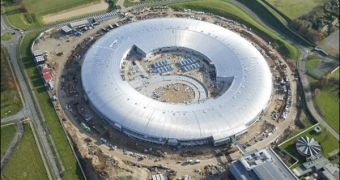The new piece of equipment currently under development at the Diamond Light Source facility, in the UK, will have as a result the birth of the first synchrotron, which will operate under high pressures that could exceed 7,000 time that of the Earth's atmosphere, equivalent to over three times the pressure on the deepest parts of the ocean floor.
Synchrotrons are a type of particle accelerators, which use magnetic fields carefully synchronized to the electric fields applied, while cyclotrons use continuous fields. They are able to generate streams of high speed subatomic particles. However, the speed is limited to an upper limit, where a particle cannot gather anymore energy, and eliminates the surplus it receives from the accelerator in the form of light, or to be more precise X-ray radiation.
The device will be able to produce high energy X-ray bursts resulted from the emissions of electrons traveling at a speed close to the speed of light, which will be used to create detailed images of organic and inorganic molecules.
Currently, the scientists are working to develop a device that will enable the study of biological samples at extremely high pressures, which could also be used to create rapid variations of pressure in the mater of a few milliseconds. According to scientists from the Imperial Department of Chemistry, the equipment will be placed in the part of the synchrotron known as "beamline I22", that will be available as a user facility, enabling the possibility for various scientists all over the UK to use it for a wide variety of experiments.
Already Dr Nick Brooks and his team, are hoping to use the equipment, in a experiment to analyze the content of biological fat molecules, and molecular structures at very high speed and resolution, under high pressure conditions. "In our work we hope to gain better understanding of the fundamental biological processes, including cell-to-cell communication and membrane biophysics", said Brooks.
The project has been funded by the Science and Technology Facilities Council, with 410,000 pounds and is expected to be operational for its first experiment in mid 2009.

 14 DAY TRIAL //
14 DAY TRIAL //